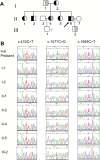Identification of compound mutations of SLC12A3 gene in a Chinese pedigree with Gitelman syndrome exhibiting Bartter syndrome-liked phenotypes
- PMID: 32758178
- PMCID: PMC7409507
- DOI: 10.1186/s12882-020-01996-2
Identification of compound mutations of SLC12A3 gene in a Chinese pedigree with Gitelman syndrome exhibiting Bartter syndrome-liked phenotypes
Abstract
Background: Gitelman syndrome is a rare salt-losing renal tubular disorder associated with mutation of SLC12A3 gene, which encodes the Na-Cl co-transporter (NCCT). Gitelman syndrome is characterized by hypokalemia, metabolic alkalosis, hypomagnesemia, hypocalciuria, and renin-angiotensin-aldosterone system (RAAS) activation. Different SLC12A3 variants may lead to phenotypic variability and severity.
Methods: In this study, we reported the clinical features and genetic analysis of a Chinese pedigree diagnosed with Gitelman syndrome.
Results: The proband exhibited hypokalaemia, hypomagnesemia, metabolic alkalosis, but hypercalciuria and kidney stone formation. The increased urinary calcium excretion made it confused to Bartter syndrome. The persistent renal potassium wasting resulted in renal tubular lesions, and might affect urinary calcium reabsorption and excretion. Genetic analysis revealed mutations of SLC12A3 gene with c.433C > T (p.Arg145Cys), c.1077C > G (p.Asn359Lys), and c.1666C > T (p.Pro556Ser). Potential alterations of structure and function of NCCT protein due to those genetic variations of SLC12A3 are predicted. Interestingly, one sibling of the proband carried the same mutant sites and exhibited similar clinical features with milder phenotypes of hypokalemia and hypomagnesemia, but hypocalciuria rather than hypercalciuria. Family members with at least one wild type copy of SLC12A3 had normal biochemistry. With administration of spironolactone, potassium chloride and magnesium supplement, the serum potassium and magnesium were maintained within normal ranges.
Conclusions: In this study, we identified compound mutations of SLC12A3 associated with varieties of clinical features. Further efforts are needed to investigate the diversity in clinical manifestations of Gitelman syndrome and its correlation with specific SLC12A3 mutations.
Keywords: Gitelman syndrome; Hypercalciuria; Hypokalemia; SLC12A3.
Conflict of interest statement
All authors declare that they have no competing of interest.
Figures



Similar articles
-
Simultaneous Homozygous Mutations in SLC12A3 and CLCNKB in an Inbred Chinese Pedigree.Genes (Basel). 2021 Mar 5;12(3):369. doi: 10.3390/genes12030369. Genes (Basel). 2021. PMID: 33807568 Free PMC article.
-
Review and Analysis of Two Gitelman Syndrome Pedigrees Complicated with Proteinuria or Hashimoto's Thyroiditis Caused by Compound Heterozygous SLC12A3 Mutations.Biomed Res Int. 2021 May 10;2021:9973161. doi: 10.1155/2021/9973161. eCollection 2021. Biomed Res Int. 2021. PMID: 34046503 Free PMC article.
-
Mutations in SLC12A3 and CLCNKB and Their Correlation with Clinical Phenotype in Patients with Gitelman and Gitelman-like Syndrome.J Korean Med Sci. 2016 Jan;31(1):47-54. doi: 10.3346/jkms.2016.31.1.47. Epub 2015 Dec 24. J Korean Med Sci. 2016. PMID: 26770037 Free PMC article.
-
The genetic spectrum of Gitelman(-like) syndromes.Curr Opin Nephrol Hypertens. 2022 Sep 1;31(5):508-515. doi: 10.1097/MNH.0000000000000818. Epub 2022 Jul 11. Curr Opin Nephrol Hypertens. 2022. PMID: 35894287 Free PMC article. Review.
-
A novel compound heterozygous mutation of SLC12A3 gene in a pedigree with Gitelman syndrome and literature review.Genes Genomics. 2020 Sep;42(9):1035-1040. doi: 10.1007/s13258-020-00960-6. Epub 2020 Jul 25. Genes Genomics. 2020. PMID: 32712837 Review.
Cited by
-
Heart's Dangerous Symphony: Torsade De Pointes Unleashed by Gitelman Syndrome-Induced Hypomagnesemia.Cureus. 2023 Aug 31;15(8):e44464. doi: 10.7759/cureus.44464. eCollection 2023 Aug. Cureus. 2023. PMID: 37791211 Free PMC article.
-
Decoding Gitelman syndrome in a structurally normal heart with polymorphic ventricular tachycardia: A case report.HeartRhythm Case Rep. 2024 Nov 21;11(3):206-209. doi: 10.1016/j.hrcr.2024.11.012. eCollection 2025 Mar. HeartRhythm Case Rep. 2024. PMID: 40182931 Free PMC article. No abstract available.
-
Could METS-VF provide a clue as to the formation of kidney stones?Front Endocrinol (Lausanne). 2023 May 22;14:1166922. doi: 10.3389/fendo.2023.1166922. eCollection 2023. Front Endocrinol (Lausanne). 2023. PMID: 37284217 Free PMC article.
-
A triple SLC12A3 heterozygous mutations in Gitelman syndrome with renal calculi.Hippokratia. 2023 Apr-Jun;27(2):64-68. Hippokratia. 2023. PMID: 39056097 Free PMC article.
References
-
- Riveira-Munoz E, Chang Q, Bindels RJ, Devuyst O. Gitelman's syndrome: towards genotype-phenotype correlations? Pediatr Nephrol. 2007;22(3):326–332. - PubMed
-
- Riveira-Munoz E, Chang Q, Godefroid N, et al. Transcriptional and functional analyses of SLC12A3 mutations: new clues for the pathogenesis of Gitelman syndrome. J Am Soc Nephrol. 2007;18(4):1271–1283. - PubMed
-
- Qin L, Shao L, Ren H, et al. Identification of five novel variants in the thiazide-sensitive NaCl co-transporter gene in Chinese patients with Gitelman syndrome. Nephrology. 2009;14(1):52–58. - PubMed
-
- Luo JW, Meng XR, Yang X, et al. Analysis of mutations of two Gitelman syndrome family SLC12A3 genes and proposed treatments using Chinese medicine. Chin J Integr Med. 2017;23(6):461–468. - PubMed
Publication types
MeSH terms
Substances
Grants and funding
LinkOut - more resources
Full Text Sources

